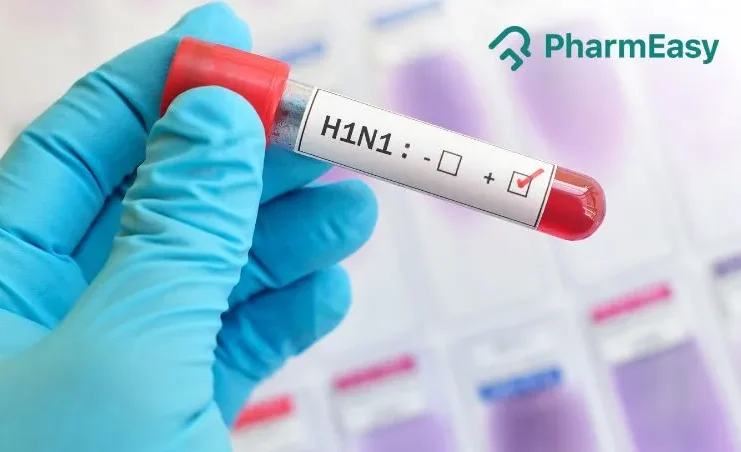H1N1 (Swine Flu): Causes, Symptoms, Treatment, and Prevention
By Dr. Vishesh Bharucha +2 more

Get,

to manage your symptom
Get your,


4 Cr+ families
benefitted

OTP sent to 9988776655



You’ve successfully subscribed to receive
doctor-approved tips on
Whatsapp

Get ready to feel your best.

Hi There,
Download the PharmEasy App now!!


Register to Avail the Offer
Send OTPBy continuing, you agree with our Privacy Policy and Terms and Conditions

Hi There,
Sign up on PharmEasy now!!
Trusted by 4 crore+ families

OTP sent to 9988776655



You have unlocked 25% off on medicines




Code: NU25
By Dr. Vishesh Bharucha +2 more
Table of Contents
H1N1, also known as swine flu, is a type of influenza A virus that was identified in humans in 2009. It emerged as a result of a mix of genes from flu viruses found in North American swine, North American birds, humans, and Eurasian swine1.
H1N1 causes respiratory illness by infecting the nose, throat, and sometimes the lungs. Its symptoms are similar to those of seasonal flu, which includes, fever, cough, sore throat, and body aches. In India, signidicant H1N1 outbreaks were recorded in 2009 and 2015, and the virus continues to circulate as a seasonal flu strain2.

The H1N1 infection can affect both the upper and lower respiratory tract. In severe cases, it may lead to complications such as viral pneumonia and acute respiratory distress syndrome (ARDS), particularly among vulnerable groups such as pregnant women, young children, the elderly, and individuals with compromised immune systems.
Vaccines that offer protection against the H1N1 virus are widely available and are included in the annual influenza vaccine recommended by global and national health authorities.
Understanding H1N1 causes, symptoms, treatment, and preventive measures is critical for managing future outbreaks and minimising health impacts. This article provides a comprehensive overview of H1N1 influenza to help increase awareness.
Swine flu, or H1N1 influenza, is a contagious viral infection caused by a subtype of the influenza A virus, primarily affecting the respiratory tract. The H1N1 virus originated from a mix of swine, bird, and human flu viruses and gained global attention during the 2009 pandemic3.
It is important to note that, although it is called “swine flu,” the virus primarily spreads through inhaling contaminated air (either from an infected person or animal) and not through the consumption of properly cooked pork3,4.
Swine flu (H1N1) is caused by the influenza A (H1N1) virus3.
Infection occurs when the virus enters the body through the nose, mouth, or eyes. The most common sources of infection include:
While the original H1N1 strain emerged from swine and was occasionally linked to close contact with infected pigs, the 2009 pandemic strain has since adapted to human transmission. In most incidences, it is not spread from pigs to humans. Instead, the virus primarily spreads through droplet transmission and fomite transmission, making person-to-person contact and surface hygiene key areas of prevention.
Swine influenza (H1N1) presents symptoms similar to seasonal influenza, ranging from mild to severe. Common H1N1 symptoms include3:
Gastrointestinal H1N1 symptoms such as nausea, vomiting, or diarrhoea are more commonly observed in children6.
While swine influenza (H1N1) can affect anyone, certain individuals are at a higher risk. These risk factors include7:
Swine flu (H1N1) is diagnosed by detecting the presence of the H1N1 virus in respiratory specimens that are typically collected using nasopharyngeal swabs, nasal swabs, or nasal aspirates, depending on the type of diagnostic test being used. Throat swabs, while sometimes collected, are generally less sensitive and not preferred for molecular testing methods such as RT-PCR, which is commonly used for confirming H1N1 infection. Early and accurate diagnosis helps guide H1N1 treatment and prevent complications.
Common diagnostic methods include8:
While many cases of swine flu (H1N1) are mild, the infection can lead to serious complications, especially in high-risk individuals. These complications may require hospitalisation and can sometimes be life-threatening. Common complications include3,9:
The H1N1 treatment focuses on reducing the severity of H1N1 symptoms, preventing complications, and stopping the spread of the H1N1 virus. Management strategies include:
Note: They are most effective when started within 48 hours of symptom onset3. Zanamivir is inhaled and not recommended for patients with asthma or COPD due to the risk of bronchospasm. Peramivir is administered intravenously and is usually reserved for hospitalised patients or those unable to take oral medications.

Practicing essential H1N1 precautions, such as those mentioned below, can significantly reduce the risk of infection:
If you are diagnosed with swine influenza (H1N1), it’s important to manage your symptoms at home while taking steps to prevent spreading the virus to others. Key guidelines for daily living while ill include:
Vaccination is one of the most effective ways to prevent H1N1.
Seasonal influenza vaccines, including quadrivalent vaccines (which also protect against both lineages of influenza B), are designed to provide immunity against the most common flu strains, including H1N1 and H3N2 (both subtypes of influenza A)12.
Also Read: Viral Fever: Causes, Symptoms, and Treatment Options
Most cases of swine flu (H1N1) are mild and can be managed at home. However, medical attention should be sought if you experience the following10:
Note: In children, watch for signs like fast breathing, irritability, poor feeding, or lack of responsiveness10. Additionally, pregnant women, the elderly, and people with underlying health conditions should consult a doctor early, even for mild symptoms.
Swine flu (H1N1) remains a significant public health concern, particularly for vulnerable populations. The H1N1 (pdm09) strain, which caused the 2009 pandemic, is now part of regular seasonal influenza circulation and no longer classified as a separate pandemic strain. Awareness of symptoms, early detection, and timely medical treatment are essential to reducing the severity and spread of the infection. Annual vaccination remains the most effective preventive measure.
In addition, following basic H1N1 precautions, such as maintaining hand hygiene, using masks, and avoiding close contact with those who are ill can reduce transmission. Public health campaigns also play a vital role in reinforcing these preventive measures, especially during flu season and among high-risk groups.
Yes, like other flu viruses, H1N1 can mutate over time6. Immunity from previous infection or vaccination may not provide full protection against new variants.
Most individuas recover within 5 to 7 days, although fatigue and cough can persist for longer3. Recovery may take more time in severe cases or in individuals with underlying health conditions.
No, antibiotics are used to treat bacterial infections, not viral illnesses like H1N1. However, they may be prescribed by a doctor if a secondary bacterial infection, such as pneumonia develops.
Swine flu is not spread by eating pork or pork products. The virus causes an infection in the respiratory tract and is not transmitted through meat. It is safe to eat properly cooked pork, as cooking meat to an internal temperature of at least 70°C (160°F) kills viruses and other pathogens13.
Disclaimer: The information provided here is for educational/awareness purposes only and is not intended to be a substitute for medical treatment by a healthcare professional and should not be relied upon to diagnose or treat any medical condition. The reader should consult a registered medical practitioner to determine the appropriateness of the information and before consuming any medication. PharmEasy does not provide any guarantee or warranty (express or implied) regarding the accuracy, adequacy, completeness, legality, reliability or usefulness of the information; and disclaims any liability arising thereof.
Comments

Leave your comment...
You may also like
Comments